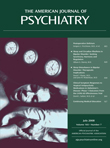Drs. McNamara and Findling Reply
To the Editor: We appreciate Dr. Rappaport’s comments on our article. We described a heuristic case that involved an adolescent with psychosis and a risk for violence at school. Because of space limitations, we were unable to include several key aspects of clinical care. As educators as well as clinicians, we consistently remind those who we teach about the importance of close communication with school personnel regarding the functioning of our patients, wherever they may be on the spectrum of risk to others. In hindsight, including content that stressed the importance of close communication between the clinician and school personnel could have strengthened our article. We agree that the use of a systematic assessment of violence risk is essential. However, it is our opinion that a reductionistic tendency of systems to rely on only one approach of risk assessment—as we have frequently seen in our own clinical practices—often does not lead to optimal placements for young, school-age patients.



